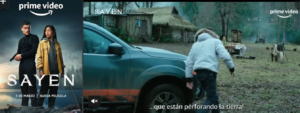Johan C Varekamp, Minerals Curator of the Joe Webb Peoples Natural History Museum, Wesleyan University
(submitted by E. Thomas)
The association between movies and minerals is not an intuitively straightforward concept, although many movies deal one way or another with diamonds (stolen or not), but about that another time. I was struck by two recent movies (streaming on Amazon and Peacock) named ‘Sayen’ and ‘The Widow’ that both have strong mineral themes. Both movies give minerals a “prime” role, in one case based on reality (The Widow), in the Sayen case it sounds possible but not very likely.
The ‘Sayen’ movie appealed to me a lot because I worked with Wesleyan undergraduates and graduate students for 17 years in the Andes in Mapuche country. The Mapuche are the original inhabitants of the Patagonian Andes and have pseudo mobile communities among which they travel, tend their animals and have their small farms. They were known as the “People of the Pehuen”, which is the highly unusual tree (Araucaria or monkey puzzle tree) of the southern Andes in Chile and Argentina. We went to Pehuen festivals at our Argentinian field site, where they celebrated the fruit of this pine-like tree, which are baked into cookies and bread. But what is the movie about? Sayen is a strong-willed young Mapuche woman living with her grandmother in Chile. Foreigners come in and want to buy their land, for a so-called nature reserve. The alert movie watchers realize that there are more nefarious issues at play here, and apparently they want to develop a cobalt deposit in this area. Cobalt is in high demand and has become a strategic element for lithium battery fabrication. I won’t tell you how it all ends (you should watch it), but for me it rang an alarm bell: pure cobalt deposits are rare or non-existing! Cobalt is an element with strong similarities to Ni, and most cobalt is mined from Ni deposits that carry a little bit of Co. In central Africa, Co is also extracted from local copper ores and in Indonesia again extracted from their rich Ni deposits. So the movie story that there is a hidden ‘cobalt deposit’ in the Mapuche land is a bit weak! Common cobalt minerals are cobaltite (CoAsS) and Carrollite (CuCo2S4). In ancient times, addition of Co to glass or ceramics gave it an intense deep blue colour (cobalt blue). Near Middle Haddam, CT, we have the small community named Cobalt where a small Co-rich rock formation is found (together with Ni and some gold!) that was mined in the 1800s. We have several Co minerals in our collection of the JWP-NH museum. A review of Co minerals and mines in Virginia is given in this link. So far for the Sayen movie story line….

‘The Widow’ TV series is a very different story, over which social scientists have expressed dismay (example of white savior complex), but it is not the worst movie you can watch. The husband of the main British protagonist goes to Kinshasha to work for an NGO and apparently dies during a plane crash near that city (and so the movie is called The Widow). Then, some years later, she sees a fleeting image of a man who looks and dresses like her husband on a TV news show about riots in Kinshasa: so off to Kinshasa she goes. The story is complex, the imagery of a massive central African city in all its chaos and poverty looks “real”, but the multiple story lines get quickly confusing. She walks with her nicely washed hair and bright white dress through the shanty towns without ever gaining a speck of dirt. Turned out her husband got caught up in the coltan trade, an abbreviation for the mineral Columbite (Fe- niobate or FeNb2O6) and the rare element Tantalum (Ta). The latter is present in all your i-Phone screens, and Columbite is a mineral common in the pegmatite rocks here around Middletown (see my ‘Minerals of Connecticut‘ blog). Ta and Nb are very similar elements (Niobe was the daughter of Tantalus in Greek mythology), and so Columbite also carries Ta, as well as small amounts of Uranium and Thorium, two common naturally occurring, radioactive elements. The coltan trade is associated with unpleasant military rebel groups in the Democratic Republic of Congo (DRC), and the mining of these toxic and radioactive minerals sure does not benefit the local population. Stolen Columbite is often smuggled into neighboring Rwanda and sold there at great profit. The movie story is rather unlikely, but provides a true and real example of mineral mining of great importance to modern high-tech industry without any regard for miners, child labour, local violence, and more. The movie plays around this theme and I thought that Kate Beckinsale played a somewhat believable person in an unrealistic story. We have beautiful pieces of Columbite in our Wesleyan JWPNH museum collection, which was first described in the 1800s from a location in Haddam, CT! Our display samples are safely entombed in thick plastic cages to block the outgoing radiation. Next time you look at your i-phone screen, think about Kate Beckinsale and all that happens in the world to enable you to talk to your mother!

